Stars, Myth, Facts, Location, Deep Sky Objects – Constellation Guide (original) (raw)
Aquarius constellation is located on the celestial equator and lies predominantly in the southern celestial hemisphere. It is one of the 12 zodiac constellations. The constellation’s name means “the water-bearer” (or “cup-bearer”) in Latin and its symbol is ♒, which represents water.
Aquarius lies in a region of the sky which is sometimes referred to as the Sea, because it contains a number of other constellations that are associated with water; Pisces (the Fish), Eridanus (the River), and Cetus (the Whale), among others. Like other zodiac constellations, Aquarius was catalogued by the Greek astronomer Ptolemy in the 2nd century CE.
Aquarius contains the yellow supergiant stars Sadalsuud (Beta Aquarii) and Sadalmelik (Alpha Aquarii), and is home to many stars with planetary systems, including TRAPPIST-1, Gliese 876, WASP-47, and HD 215152.
The Water Bearer constellation hosts a number of notable deep sky objects, among them the globular clusters Messier 2 and Messier 72, the Aquarius Dwarf Galaxy, the Atoms for Peace Galaxy (NGC 7252) and two well-known planetary nebulae: the Saturn Nebula and the Helix Nebula.
Facts, location and map
Aquarius is the 10th largest constellation in the sky, occupying an area of 980 square degrees. It is one of the 15 equatorial constellations. Most of the constellation is located in the fourth quadrant of the southern hemisphere (SQ4). The entire constellation is visible from locations between the latitudes +65° and -90°. The neighboring constellations are Aquila, Capricornus, Cetus, Delphinus, Equuleus, Pegasus, Pisces, Piscis Austrinus, and Sculptor.
The constellation name Aquarius is pronounced /əˈkwɛəriəs/. In English, the constellation is known as the Water-Bearer. The genitive form of Aquarius, used in star names, is Aquarii (pronunciation: /əˈkwɛəriaɪ/). The three-letter abbreviation, adopted by the International Astronomical Union (IAU) in 1922, is Aqr.
Aquarius contains two stars brighter than magnitude 3.00 and seven stars that are located within 10 parsecs (32.6 light years) of Earth. The brightest star in the constellation is Beta Aquarii, also known as Sadalsuud, with an apparent magnitude of 2.87. The nearest star is EZ Aquarii, a triple star system composed of three M-type dwarfs, located at a distance of 11.11 light years from Earth.
The constellation contains 13 named stars. The star names approved by the International Astronomical Union (IAU) are Albali (Epsilon Aquarii A), Ancha (Theta Aquarii), Bosona (HD 206610), Bunda (Xi Aquarii A), Lionrock (HD 212771), Márohu (WASP-6), Sadachbia (Gamma Aquarii Aa), Sadalmelik (Alpha Aquarii), Sadalsuud (Beta Aquarii), Situla (Kappa Aquarii A), Skat (Delta Aquarii A), Wouri (WASP-69), and Zembra (HATS-72).
Aquarius belongs to the zodiac family of constellations, along with Aries, Taurus, Gemini, Cancer, Leo, Virgo, Libra, Scorpius, Sagittarius, Capricornus, and Pisces.
The constellation contains three Messier objects: Messier 2 (NGC 7089), Messier 72 (NGC 6981), and Messier 73 (NGC 6994). There are four meteor showers associated with Aquarius: the March Aquariids, Eta Aquariids, Delta Aquariids, and Iota Aquariids.
The best time of the year to see Aquarius is during the month of October, when the celestial Water Bearer appears higher above the horizon around 9 pm. Even though it lies predominantly in the southern sky, Aquarius is easily visible from the northern hemisphere because it lies on the celestial equator.
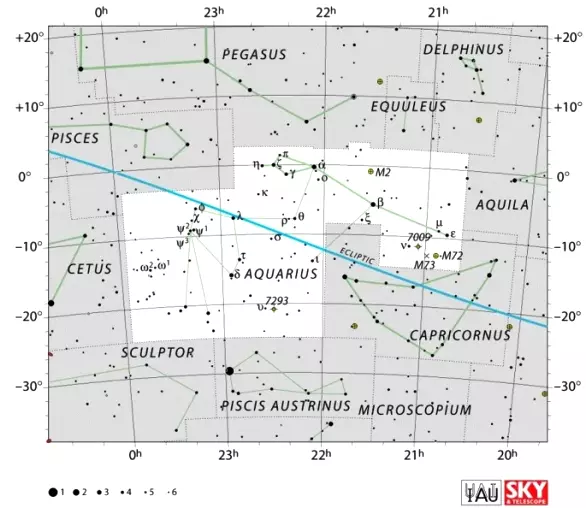
Aquarius constellation map, by IAU and Sky&Telescope magazine (Roger Sinnott & Rick Fienberg) (CC BY 3.0)
Aquarius myth
Aquarius is depicted as a young man pouring water (or alternatively, nectar) from an amphora into the mouth of the Southern Fish, represented by the bright star Fomalhaut in the constellation Piscis Austrinus. The stream of stars representing the water poured by the Water Bearer towards Fomalhaut may be spotted on a clear, dark night.
In the Early Bronze Age, Aquarius contained the winter solstice.
In Greek mythology, Aquarius is usually associated with Ganymede, the son of King Tros. Ganymede was a beautiful Trojan youth who caught Zeus’ eye, which prompted the god to disguise himself as an eagle (represented by the constellation Aquila) and carry Ganymede off to Olympus to serve as cupbearer to the gods.
In a different story, the constellation represents Deucalion, son of Prometheus, who survived the great flood along with his wife Pyrrha.
In Babylonian myths, Aquarius is identified as GU.LA (the great one), the god Ea himself. The Babylonians typically depicted Ea holding an overflowing cup or vase.
In Egyptian tales, the constellation represented Hapi, the god of the Nile river. The Egyptians associated Hapi with the annual flooding of the Nile and celebrated the androgynous figure as the bringer of fertile soil.
Asterisms
Aquarius contains the Water Jar, a visible asterism that is part of the constellation figure of the Water Bearer. It is the most prominent constellation-based asterism in Aquarius. The telescopic asterism Messier 73 appears near the bright globular cluster Messier 72. It is one of two asterisms listed in the Messier catalogue.
The constellation’s brightest stars, the supergiants Sadalsuud and Sadalmelik, form an asterism known as the Lightning Bolt with the luminaries of the neighbouring constellations Pegasus and Capricornus.
Water Jar
The Water Jar is a small asterism formed by Zeta, Gamma, Eta and Pi Aquarii. It represents the water jar from which the Water Bearer is pouring water in the direction of Fomalhaut, the bright star that marks the mouth of the Southern Fish (Piscis Austrinus). The asterism is also known as the Urn.
The star pattern is not particularly bright, but it is distinctive and can be spotted near the brighter and larger Great Square of Pegasus on a clear, dark night. Zeta Aquarii, the central star in the asterism, is the brightest of the four stars, with an apparent magnitude of 3.65. The faintest, Pi Aquarii, shines at magnitude 4.57, making the asterism a difficult target from urban areas.
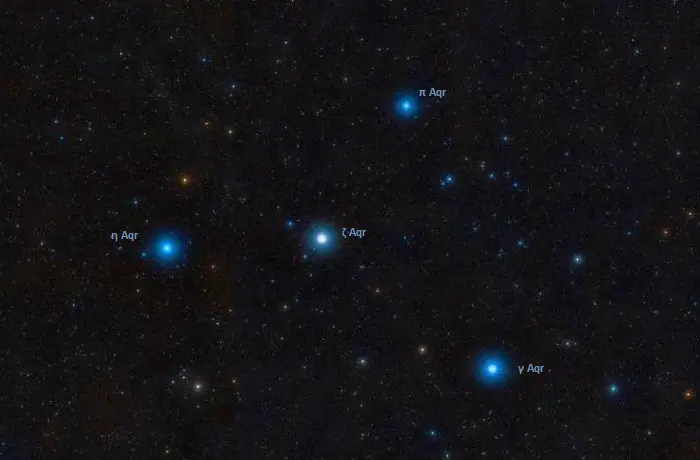
The Water Jar asterism in Aquarius, image: Wikisky (DSS2)
Messier 73 (NGC 6994)
Messier 73 is an asterism formed by four stars that appear close to each other in the night sky, but are not physically associated with each other. They lie 1,030, 1,249, 2,170, and 2,290 light-years away. One of them is a binary star system.
M73 is located 1.5 degrees east of the globular cluster Messier 72. It used to be treated as a sparse open cluster until 2002, when an analysis proved that the six brightest stars in the “cluster” not only lay at very different distances from Earth, but also that they were moving in different directions. Astronomers concluded that M73 was an asterism – a chance alignment of stars – and not an open cluster.
Charles Messier discovered the object in 1780 and described it as a cluster of four stars with some nebulosity. English astronomer John Herschel was not entirely convinced that M73 was a cluster, but included it in his General Catalogue of clusters, nebulae, and galaxies. The asterism is listed as NGC 6994 in the New General Catalogue and as Collinder 426 (Cr 426) in the Collinder catalogue of open clusters.
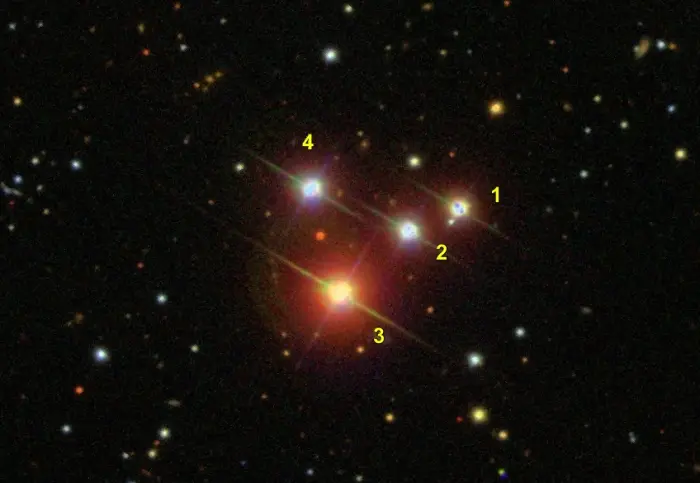
Messier 73 – Image created using the Aladin Sky Atlas software from the Strasbourg Astronomical Data Center and SDSS (Sloan Digital Sky Survey) public data, credit: Domald Pelletier (CC BY-SA 4.0)
Lightning Bolt
The Lightning Bolt is an asterism formed by the supergiants Sadalsuud and Sadalmelik in Aquarius with Enif in Pegasus and Deneb Algedi in Capricornus. Sadalmelik appears just west of the Water Jar.
The four relatively bright, evolved stars form a zig-zag pattern that begins at Enif (Epsilon Pegasi), the brightest star in Pegasus, and continues with the two brightest stars in Aquarius to Deneb Algedi (Delta Capricorni), the lucida of Capricornus.
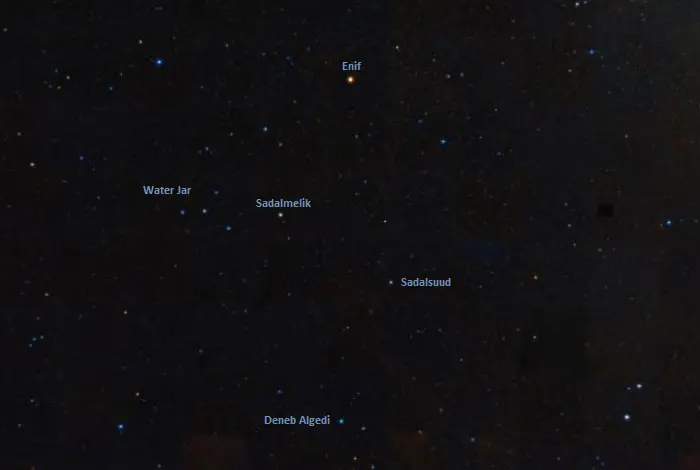
The Lightning Bolt, image: Wikisky (DSS2)
Major stars in Aquarius
The stars of Aquarius are not particularly bright. The constellation contains only two stars brighter than magnitude 3.0, the yellow supergiants Sadalsuud and Sadalmelik. Both stars shine at third magnitude. Most other relatively bright stars in Aquarius shine at fourth magnitude and are difficult to see from light-polluted areas. The constellation does not contain any navigational stars.
Sadalsuud and Sadalmelik represent the celestial Water Bearer’s left and right shoulders. The head of Aquarius is marked by the fainter orange giant 25 Aquarii. Sadachbia marks his right forearm and the water jar (amphora) is represented by an asterism formed by Gamma, Pi, Eta, and Zeta Aquarii.
Aquarius contains many notable stars with known exoplanets and planetary systems. These include the red dwarfs TRAPPIST-1 with seven planets, Gliese 876 with four planets and Gliese 849 with two, the yellow dwarf WASP-47 with four planets, and the orange dwarfs HD 215152 with four planets and 91 Aquarii A with one planet.
Sadalsuud – β Aquarii (Beta Aquarii)
Sadalsuud (β Aqr) is the brightest star in Aquarius. It has an apparent magnitude of 2.87 and is approximately 541.55 light years distant. With the stellar classification G0 Ib, it belongs to a rare class of stars, the yellow supergiants.
Sadalsuud has a radius 47.88 times that of the Sun. With an effective temperature of 5,608 K, it is 2,046 times more luminous than the Sun. Estimates of the supergiant’s mass are in the range between 4.97 and 6.3 solar masses, not enough to make the star a supernova candidate. The evolved star has an estimated age of 56 – 110 million years.
Sadalsuud is believed to have formed in the same stellar nursery as the fellow yellow supergiant star Sadalmelik and the K-type red supergiant Enif (Epsilon Pegasi), the brightest star in Pegasus. The three bright stars form an OB triple system and their space velocities are taking them in a direction perpendicular to the Milky Way plane. They form the Lightning Bolt asterism with Deneb Algedi in the neighbouring Capricornus constellation.
Sadalsuud has two optical companions, a magnitude 11 star at a separation of 35.4 arcseconds and a magnitude 11.6 star located 57.2 arcseconds away. The companions lie at twice the distance of Sadalsuud and are not physically related to the supergiant.
The name Sadalsuud comes from the Arabic phrase sa’d al-suud, meaning the “luck of lucks.” It was historically sometimes also spelled Nir Saad al Saaoud, Sadalsund, Saad el Sund, and Sad es Saud.
The star’s Latin name was Lucida Fortunae Fortunarum, meaning “the brightest luck of lucks.” In Egyptian, Persian and Arabic mythology, Sadalsuud was associated with the spring and the good fortune brought by the Sun when it rises after winter has passed.
Sadalmelik – α Aquarii (Alpha Aquarii)
Sadalmelik (α Aqr) is a yellow supergiant of the spectral type G2 Ib, located approximately 690.8 light-years away. With an apparent magnitude of 2.942, it is the second brightest star in Aquarius.
The supergiant star has a mass 6.31 times that of the Sun and has expanded to a size of 83 solar radii. With a surface temperature of about 5,190 K, it shines with 3,917 solar luminosities. It is only around 53 million years old.
The star has a visual companion at a separation of 110.4 arcseconds. The companion has an apparent magnitude of 12.2.
The name Sadalmelik is derived from the Arabic phrase sa’d al-malik, which means “the luck of the king” or “the lucky stars of the king.” Sometimes the star was also called Ruchbah, a name that now formally applies to Delta Cassiopeiae.
Skat – δ Aquarii (Delta Aquarii)
Skat (δ Aqr) is a white main sequence star of the spectral type A3Vp. It lies 113 light-years away. With an apparent magnitude of 3.28, it is the third brightest star in Aquarius.
Skat has a mass of 2.51 solar masses and a radius 2.4 times that of the Sun. It shines with 48 solar luminosities and has an effective temperature of 8,650 K. It spins at 81 km/s. The star has an estimated age of 0.3 billion years.
In 2017, observations confirmed a close companion for Delta Aqr. The companion is believed to be a yellow dwarf star of the spectral type G5. It is separated by only around 2 astronomical units (Earth – Sun distances) from Skat.
Skat shares its traditional name with Beta Pegasi (Scheat). The name is derived from the Arabic as-saq, meaning “shin” or “leg.”
Delta Aquarii is believed to be a member of the Ursa Major Moving Group (Collinder 285), an association of stars that includes the most prominent stars of Ursa Major, which share common velocities and origin.
The radiant of the Southern Delta Aquariids appears near Skat in the sky. The Southern Delta Aquariid meteor shower occurs from mid-July to mid-August every years and peaks on July 28-29. At its peak, it produces 15 – 20 meteors per hour.
The weaker Northern Delta Aquariids peak in mid-August. The meteor shower is visible from July 16 to September 10. It produces 10 meteors per hour on average at the peak.
ζ Aquarii (Zeta Aquarii)
Zeta Aquarii (ζ Aqr) is a triple star system located approximately 92 light-years away. The system has a combined apparent magnitude of 3.65. It is the central point of light in the Water Jar asterism.
The Zeta Aquarii system consists of two visual components, Zeta Aquarii A and Zeta Aquarii B. The two components have apparent magnitudes of 4.42 and 4.51 and orbit each other with a period of 540 ± 15 years. They are separated by about 3.5 arcseconds in the sky.
Zeta Aquarii A has the spectrum of a main sequence star of the spectral type F3 V, while the more evolved Zeta Aquarii B appears as a subgiant of the spectral type F6 IV.
Zeta Aqr A is itself an astrometric binary system. The companion is invisible, but its presence is indicated by the primary component’s wobble around the common centre of mass. The components Zeta Aquarii Aa and Ab are separated by only 0.385 arcseconds and have an orbital period of 25.95 years. The more massive component Zeta Aqr Aa has a mass of 1.4 solar masses and Zeta Aqr Ab, 0.6 solar masses. The system has an estimated age of 1 billion years. The more distant Zeta Aquarii B has the same mass as the component Aa, 1.4 solar masses.
Zeta Aquarii was traditionally known as Sadaltager (or Altager), derived from the Arabic phase sa’d al-tajir, meaning “the luck of the merchant,” but the name has not been formally approved by the International Astronomical Union (IAU).
TRAPPIST-1
TRAPPIST-1 is a red dwarf star located 40.66 light-years away. With an apparent magnitude of 18.798, it is invisible to the unaided eye. The ultracool red dwarf hosts a system of seven confirmed exoplanets, discovered in 2016. At the time of discovery, TRAPPIST-1 set a new record for the number of potentially habitable planets orbiting a single star.
TRAPPIST-1 has the stellar classification M8V. With a surface temperature of 2,566 K, it shines with 0.000553 solar luminosities (0.0553% of the Sun’s luminosity). It has less than 9% of the Sun’s mass and a radius of 0.1192 solar radii, only slightly larger than that of Jupiter. The star is older than the Sun, with an estimated age of 7.6 billion years. It was discovered by John Gizis, a professor of physics and astronomy at the University of Delaware, in 1999.
The planetary system around TRAPPIST-1 was discovered using the Transiting Planets and Planetesimals Small Telescope (TRAPPIST) at La Silla Observatory in Chile, the Spitzer Space Telescope, and several ground-based telescopes in 2016. The first two planets were detected in 2016 and, after further analysis of the observations, astronomers discovered five more planets. The planets were discovered by a team led by Belgian astronomer and astrophysicist Michaël Gillon at the University of Liège.
The seven planets are designated TRAPPIST-1b, c, d, e, f, g, and h. They take between 1.5 and 19 days to complete an orbit around TRAPPIST-1. They orbit the parent star at distances between 0.011 and 0.059 astronomical units (Earth – Sun distances). All seven planets are believed to be tidally locked to the star (always facing the star from the same side). They have masses comparable to that of Earth (0.326 – 1.374 Earth masses), as well as similar composition, but they are less dense than our planet.
Three or four planets may orbit in the star’s habitable zone, i. e. at distances where their temperatures would allow liquid water to exist on the surface. These are the planets TRAPPIST-1e, f and g or TRAPPIST-1d, e and f. Researchers found that the planet TRAPPIST-1e was the most likely to be an Earth-like ocean planet.
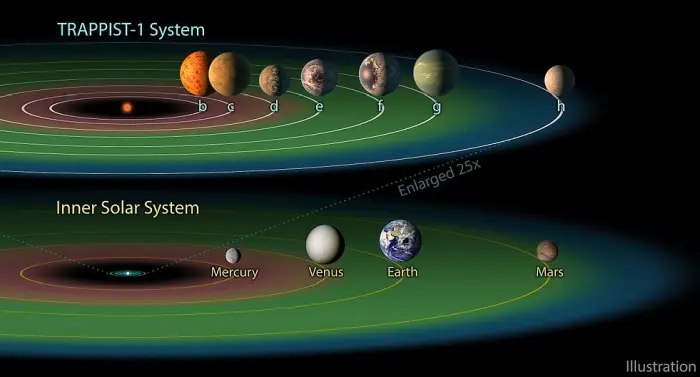
The TRAPPIST-1 system contains a total of seven planets, all around the size of Earth. Three of them — TRAPPIST-1e, f and g — dwell in their star’s so-called habitable zone. The habitable zone, or Goldilocks zone, is a band around every star (shown here in green) where astronomers have calculated that temperatures are just right — not too hot, not too cold — for liquid water to pool on the surface of an Earth-like world. While TRAPPIST-1b, c and d are too close to be in the system’s likely habitable zone, and TRAPPIST-1h is too far away, the planets’ discoverers say more optimistic scenarios could allow any or all of the planets to harbor liquid water. In particular, the strikingly small orbits of these worlds make it likely that most, if not all of them, perpetually show the same face to their star, the way our moon always shows the same face to the Earth. This would result in a dramatic range of temperatures from the day to night sides, allowing for situations not factored into the traditional habitable zone definition. The illustrations shown for the various planets depict a range of possible scenarios of what they could look like. Image credit: NASA/JPL-Caltech (PD)
EZ Aquarii
EZ Aquarii is the 12th nearest star system to the Sun. Composed of three red dwarfs, the system lies 11.11 light-years away. It has a combined apparent magnitude of 12.38 and is invisible to the unaided eye. The system is also catalogued as Luyten 789-6, LHS 68, and Gliese 866.
The EZ Aquarii system has a total mass of 0.3262 ± 0.0018 solar masses. The individual three components have masses around 10% that of the Sun. The inner two components, EZ Aquarii A and C, form a spectroscopic binary system with an orbital period of 3.8 days. The stars are separated by only 0.03 astronomical units. The component EZ Aquarii B orbits the main pair with a period of 823 days.
Like many other nearby red dwarfs, EZ Aqr is classified as a flare star and a BY Draconis variable. The occasional flaring activity causes sudden increases in the star’s brightness. Brightness variations are also caused by starspots combined with the effects of rotation.
EZ Aquarii is approaching the Sun and will come within 8.2 light-years of the solar system in about 32,300 years.
The nearest neighbour of EZ Aquarii is the red dwarf Lacaille 9352, which lies 4.1 light-years from EZ Aqr and 10.7241 light-years from the Sun. Lacaille 9352 is the nearest star in the constellation Piscis Austrinus.
Fomalhaut C (LP 876-10)
LP 876-10 (Alpha Piscis Austrini C or Fomalhaut C) is a red dwarf located 25.037 light-years from Earth. It is the third component of the Alpha Piscis Austrini (Fomalhaut) system. With an apparent magnitude of 12.624, the dwarf star is invisible to the unaided eye.
Fomalhaut C is the least massive component of the Fomalhaut system. It has only 18% of the Sun’s mass and 23% of its radius.
Fomalhaut is the brightest star in the neighbouring constellation Piscis Austrinus (the Southern Fish) and the 18th brightest star in the sky. It is an A-type main sequence star with a mass 1.92 times that of the Sun. The faint Aquarius stars representing the water poured by the Water Bearer into the mouth of the Southern Fish (marked by Fomalhaut) can be seen on a very clear, dark night.
Fomalhaut’s brighter companion, TW Piscis Austrini (mag. 6.48), lies 0.91 light-years from Fomalhaut. It is an orange main sequence star with around 70.4% of the Sun’s mass. The visual separation between Fomalhaut and Fomalhaut B (TW PsA) is 2 degrees, equal to four full Moons.
Fomalhaut C lies even farther away and appears in a different constellation. It is separated from Fomalhaut by 5.7 degrees and lies about halfway between Fomalhaut and the Helix Nebula. The physical distance between Fomalhaut and Fomalhaut C is 2.5 light-years, and between Fomalhaut B and Fomalhaut C it is 3.22 light-years.
Like the brighter Fomalhaut, Fomalhaut C has a cold debris disk, discovered with the Herschel Space Telescope in 2013. The dusty disk was observed by the Atacama Large Millimeter/submillimeter Array (ALMA) in 2021 and by the James Webb Space Telescope (JWST) in 2024.
Sneden’s Star
Sneden’s Star (BPS CS22892-0052) is a population II star located approximately 17,000 light-years away. With an estimated age of 13 billion years, it is one of the oldest stars known.
The ultra-metal-poor star resides in the Milky Way’s halo. Like all population II stars, it formed when the universe was much younger. It was discovered by a team led by American astrophysicist Timothy C. Beers during observations with the Curtis Schmidt telescope at the Cerro Tololo Inter-American Observatory in Chile in the early 1990s.
BPS CS22892-0052 was named Sneden’s Star after Christopher A. Sneden from the University of Texas at Austin, who led a team of observers who determined the abundances of 53 chemical elements in the star. This allowed scientists to determine the star’s age.
88 Aquarii
88 Aquarii (c2 Aquarii) is an orange giant of the spectral type K1 III. It shines at magnitude 3.679 from a distance of 271 light-years. It has a radius about 29 times that of the Sun and a surface temperature of 4,430 K. The star appears in the southern part of Aquarius, near the border with Piscis Austrinus.
λ Aquarii (Lambda Aquarii)
Lambda Aquarii (λ Aqr) is a red giant star of the spectral type M2.5 IIIa Fe–1. It shines at magnitude 3.722 from a distance of 365 light years.
The star is currently on the asymptotic giant branch (AGB), an advanced stage in the evolution of intermediate mass stars. It has a mass 3.6 times that of the Sun and has expanded to a size of 100.17 solar radii. With an effective temperature of 3,702 K, it shines with 1,716 solar luminosities.
Lambda Aquarii is classified as a slow irregular variable (type Lb). It pulsates with periods of 24.5, 32.0, and 49.5 days.
The star has the traditional names Hydor (Ὕδωρ) and Ekkhysis (εκχυσις), which mean “water” and “outpouring” in ancient Greek. It does not have a proper name formally approved by the International Astronomical Union (IAU).
Albali – ε Aquarii (Epsilon Aquarii)
Albali (ε Aqr) is a binary star system located 244 light-years away in Aquarius, near the border with Capricornus (the Sea-Goat). It has an apparent magnitude of 3.77.
The star system is composed of a blue-white main sequence star of the spectral type A1 V and an orange main sequence star. More recent sources give the spectral class B9.5V for the primary component. The two stars orbit each other with a period of 1.2 years at a separation of 1.7 astronomical units. They are separated by 25.9 milliarcseconds in the sky.
Epsilon Aquarii A has a mass 2.98 times that of the Sun and a radius 4.2 times the Sun’s. It has a surface temperature of 9,622 K and shines with 161 solar luminosities. The star is a fast rotator, spinning at 118 km/s. It has an estimated age of 388 million years.
The companion, Epsilon Aquarii B, has 61% of the Sun’s mass and 57% of its radius. With a surface temperature of 4,070 K, it is classified as a K-type star.
The star’s traditional name, Albali, comes from the Arabic albāli‘, meaning “the swallower.” The name refers to an old asterism called al Bulaʽ (“the Swallower”), formed by Epsilon Aquarii with Mu and Nu Aquarii. Epsilon Aquarii was historically also called Nir Saad Bula, meaning “the brightest luck of the swallower.” The IAU approved the name Albali for the star in 2016. The name applies only to the primary component.
Sadachbia – γ Aquarii (Gamma Aquarii)
Sadachbia (γ Aqr) is a double star system located approximately 164 light-years away. It has an apparent magnitude of 3.849.
The Gamma Aquarii system is composed of a main sequence star of the spectral type A0 V and a smaller K-type companion. The companion was only directly observed in 2024 using the GRAVITY interferometer on the Very Large Telescope Interferometer (VLTI). The two components are separated by 1.9 astronomical units. They take about a year to complete an orbit around a common centre of mass.
The primary component has 2.72 times the Sun’s mass and a radius 2.7 times solar. It has a surface temperature of 10,637 K and spins at 80 km/s. It has an estimated age of around 280 million years.
The companion has only 56% of the Sun’s mass and a radius half that of the Sun. It is much cooler than the primary star, with an effective temperature of 3,900 K.
The name Sadachbia is derived from the Arabic sa‘d al-’axbiyah, meaning “the luck of the homes” or “the luck of the tents.” It is associated with an old Arabic asterism called the Tent, formed by Gamma Aquarii with Zeta, Pi and Eta Aquarii.
Ancha – θ Aquarii (Theta Aquarii)
Ancha (θ Aqr) is a yellow giant or subgiant star of the spectral class G8, located 187 light-years away. It has an apparent magnitude of 4.175.
The star has a mass of 2.39 – 2.78 solar masses and a radius 12 times that of the Sun. With a surface temperature of 4,864 K, it is between 72 and 83 times more luminous than the Sun. It has an estimated age of 437 million years.
The name Ancha comes from Medieval Latin and means “the haunch.” It has the same pronunciation as Ankaa, the name of Alpha Phoenicis, derived from the Arabic word for “the phoenix.”
ψ1 Aquarii (Psi1 Aquarii)
Psi1 Aquarii (ψ1 Aqr, 91 Aquarii) is a triple star system located approximately 150 light-years from the Sun. It shines at magnitude 4.248.
The primary component, 91 Aquarii A, is an orange giant of the spectral type K1 III. It has a mass of 1.38 solar masses and a radius 10.96 times that of the Sun. With an effective temperature of 4,730 K, it is 54.3 times more luminous than the Sun. The star has an estimated age of 2.98 billion years.
91 Aquarii A hosts an exoplanet, discovered in 2003. The planet, 91 Aquarii b or HD 219449 b, has a mass at least 3.2 times that of Jupiter. It orbits the parent star with a period of 181.4 days at a distance of 0.70 astronomical units.
The two fainter components of the 91 Aquarii system have apparent magnitudes of 9.62 and 10.10. They form a binary system separated by 52 arcseconds from 91 Aqr A.
Bunda – ξ Aquarii (Xi Aquarii)
Bunda (ξ Aqr) is a single-lined spectroscopic binary system located approximately 179 light-years away. The two components orbit each other with a period of 8,016 days.
The primary component is a main sequence star of the spectral type A7 V. It has 1.9 times the Sun’s mass and a surface temperature of 7,691 K. The star is a very fast spinner, with a projected rotational velocity of 170 km/s.
The unseen companion is either a red dwarf or a white dwarf with a mass 90% that of the Sun.
Xi Aquarii was named Bunda after the Persian lunar mansion Bunda, which it formed with the brighter Sadalsuud. The star’s Latin name was Secunda Fortunæ Fortunarum, “the second luck of lucks.”
Situla – κ Aquarii (Kappa Aquarii)
Situla (κ Aqr) is believed to be a wide binary star system located 214 light-years away. It has an apparent magnitude of 5.03.
The primary component is an orange giant star of the spectral type K2 III. It has a radius 13 times that of the Sun and shines with a luminosity of 60 Suns.
The giant star probably forms a wide binary system with a fainter companion at a separation of 98.3 arcseconds. The companion has an apparent magnitude of 8.8.
Situla, the traditional name of Kappa Aqr, means “bucket” or “water jar” in Latin.
R Aquarii
R Aquarii is a symbiotic star located approximately 711 light-years away. It is one of the closest symbiotic stars to the Sun. The binary system is composed of a red giant and a white dwarf. The two components have an orbital period of about 44 years. They are separated by only 55 milliarcseconds.
The primary component, the red giant, is classified as a Mira variable. It varies in brightness due to pulsations of its surface, which cause variations in temperature. The giant star’s brightness has been observed to vary between magnitude 5.2 and 12.4. At its brightest, the star is visible to the unaided eye in good conditions. At its faintest, it is 750 times fainter and cannot even be seen in binoculars. The star pulsates with a period of 390 days, but the pulsation cycles are not completely regular.
R Aquarii has a mass of 1 – 1.5 solar masses and a radius 430 times that of the Sun. With an effective temperature of 2,800 K, it is 4,780 times more luminous than the Sun.
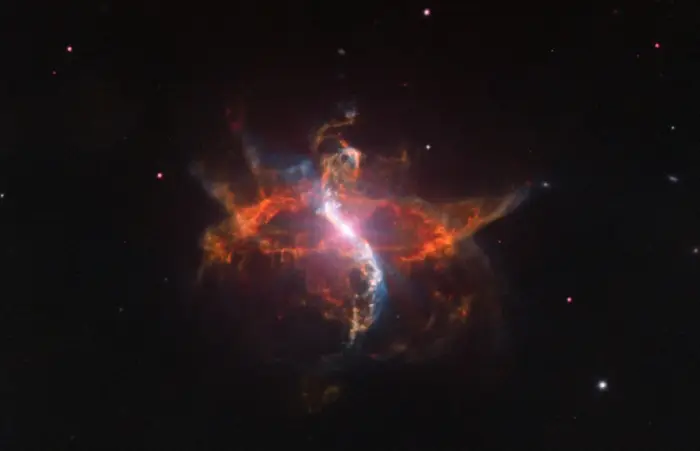
This image reveals a dramatic binary star system named R Aquarii, located 700 light-years from Earth, as seen in 2012 by ESO’s Very Large Telescope (VLT). R Aquarii is a so-called “symbiotic binary”, comprising two stars surrounded by a large, dynamic cloud of gas (a nebula). Systems like this contain two stars in an unequal and complex relationship. R Aquarii is made up of one hot white dwarf and one red giant. The red giant is losing matter to its small companion and occasionally ejecting matter in weird spurts, loops and trails, forming the intriguing shapes seen here. There is a lot going on between the performers in this cosmic double act. The red giant is a variable star, with a brightness that changes by a factor of 750 every year and three weeks. The faint nebula is named Cederblad 211 and is thought to be the result of a nova 250 years ago. Also visible is a narrow, vertical, S-shaped feature, with blobs of superheated material moving outward at tremendous speeds of 600 to 850 kilometres per second. Image credit: ESO (CC BY 4.0)
The companion, the white dwarf, has a mass of 0.6 – 1 solar mass and a radius at least 10% that of the Sun. With a surface temperature of 60,000 K, it shines with 5 – 20 solar luminosities.
The R Aquarii system is classified as a Z Andromedae variable, or a symbiotic binary. Symbiotic stars typically consist of a red giant that loses material through its stellar wind and a white dwarf that accumulates the ejected material.
In the R Aquarii system, the gravitational pull of the white dwarf draws in material from the larger companion and expels some of it to form a nebula. The nebula is catalogued as Cederblad 211. It may be associated with a nova-like eruption recorded by observers in Japan in the year 930 CE.
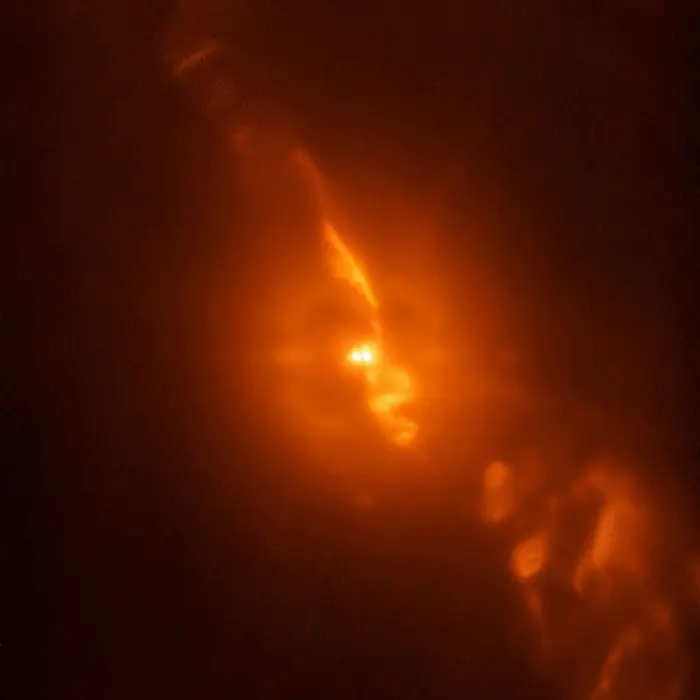
While testing a new subsystem on the SPHERE planet-hunting instrument on ESO’s Very Large telescope, astronomers were able to capture dramatic details of the turbulent stellar relationship in the binary star R Aquarii with unprecedented clarity — even compared to observations from the NASA/ESA Hubble Space Telescope. This image is from the SPHERE/ZIMPOL observations of R Aquarii, and shows the binary star itself, as well as the jets of material spewing from the stellar couple. Image credit: ESO/Schmid et al. (CC BY 4.0)
Lionrock (HD 212771)
Lionrock (HD 212771) is a yellow subgiant star located approximately 364 light-years away. With an apparent magnitude of 7.6, it is visible in binoculars. It has the stellar classification G8 IV.
The star has a mass of 1.56 solar masses and a radius 5.7 times that of the Sun. It is 11.55 times more luminous than the Sun with an effective temperature of 5,003 K. The star has an estimated age of 1.676 billion years.
HD 212771 hosts an extrasolar planet, HD 212771 b, discovered in 2010. The planet has at least 2.39 times the mass of Jupiter and orbits the host star with a period of 381 days at a distance of 1.19 astronomical units.
HD 212771 was named Lionrock, after the Lion Rock mountain in Hong Kong, during the International Astronomical Union’s 2019 NameExoWorlds campaign. The planet HD 212771 b was named Victoriapeak, after the Victoria Peak (Mount Austin) in Hong Kong.
Bosona (HD 206610)
Bosona (HD 206610) is an orange subgiant star of the spectral type K0 III. It lies 482 light-years from Earth. With an apparent visual magnitude of 8.34, it is invisible to the unaided eye. The star hosts an orbiting planet, HD 206610 b, discovered in 2010.
Bosona has 1.51 times the Sun’s mass and has expanded to a size of 6.0 solar radii as it evolved away from the main sequence. It has a surface temperature of 4,819 K and shines with 18 solar luminosities. It has an estimated age of 3 billion years.
The planet, formally named Naron, has a mass of at least 2.036 Jupiter masses and an orbital period of 673.2 days. It orbits the star at a distance of 1.74 AU.
The star and the planet were named Bosona and Naron during the 2019 NameExoWorlds campaign. The proposals for the names came from Bosnia and Herzegovina. Bosona is the old name for Bosnia and Naron is one of the historic names of the Neretva river.
Gliese 876
Gliese 876 (GJ 876) is a red dwarf (M4V) located only 15.238 light-years away. With an apparent magnitude of 10.1920, it is only visible in telescopes. It hosts four orbiting planets, discovered between 1998 and 2005.
The planets are designated Gliese 876 b, c, d and e. The planets b and c orbit in the star’s habitable zone, but they are Jovian planets, composed mainly of volatiles rather than rock. Gliese 876 d, the innermost known planet, may be a terrestrial planet, with a mass 6.7 times that of the Earth. Gliese 876 e, the outermost planet, has 16 times the mass of the Earth, which is comparable to the mass of Uranus.
The star Gliese 876 has only 34.6% of the Sun’s mass and 37.2% of its radius. It is classified as a BY Draconis variable and has the variable star designation IL Aquarii. Its brightness has been observed to vary by about 0.4 magnitudes. The brightness variations are caused by large starspots combined with the effect of rotation.
The planetary system of Gliese 876 is the only orbiting system known that shows a near-triple conjunction of the three outer planets once per orbit of the outermost planet. The planets’ orbits are locked in a Laplace resonance, with a simple integer ratio (1:2:4) between their orbital periods, like Jupiter’s moons Ganymede, Europa and Io.
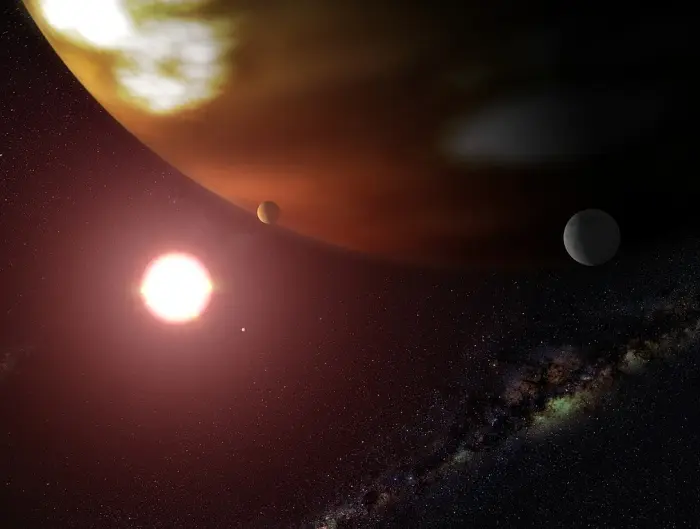
This is an artist’s concept of a gas giant planet orbiting the cool, red dwarf star Gliese 876, located 15 light-years away in the autumn constellation Aquarius. The planet was discovered in 1998. But new Hubble Space Telescope measurements of the star’s wobble, caused by the gravitational tug of the planet, firmly establish the planet’s mass as being no more than approximately twice that of Jupiter’s. The planet is only one fifth the distance from the star as the Earth is from the Sun. Though it is too far away to be photographed by present day telescopes, the planet is presumably a gas giant world that might be encircled by moons, as imagined in this illustration. Gliese 876 also has an inner planet with a mass only half that of Jupiter’s, as estimated by earlier ground-based observations. The inner gas planet in the system appears as a bright star-like object near the red dwarf. Despite its close proximity to Earth, the red dwarf star is one third the mass of our Sun and is too faint to be seen by the unaided eye. Image credit: NASA/ESA and G. Bacon (STScI) (PD)
Gliese 849
Gliese 849 (GJ 849) is a red dwarf of the spectral type M3.5V. It has an apparent magnitude of 10.41 and lies 28.750 light-years away. It hosts two exoplanets, Gliese 849 b and c.
The star has a mass of 0.465 solar masses and a radius of 0.464 solar radii. It is believed to be at least 3 billion years old.
The planet Gliese 849 b has at least 89.3% of Jupiter’s mass and orbits the parent star with a period of 1,925.31 days at a distance of 2.32 AU. Gliese 849 c has a mass of at least 0.99 Jupiter masses. It has an orbital period of 5,990 days and a semimajor axis of 4.95 AU.
Discovered in 2006, Gliese 849 b was the first extrasolar planet found orbiting an M-type dwarf with a semimajor axis of more than 0.21 AU.
Márohu (WASP-6)
Márohu (WASP-6) is a yellow dwarf star of the spectral type G8V, located 651 light-years away. With an apparent visual magnitude of 11.9, it is invisible to the unaided eye.
The star has a mass of 0.880 solar masses and a radius of 0.870 solar radii. It spins at around 1.4 km/s, taking 23.80 days to complete a rotation. It is much older than the Sun, with an estimated age of around 11 billion years.
The catalogue designation WASP-6 indicates that Márohu was the sixth star discovered to have an orbiting planet by the Wide Angle Search for Planets (WASP) detection program.
The planet, WASP-6b, was detected in 2008. It has 48% of Jupiter’s mass and orbits the parent star at a distance of 0.04217 AU (4.217% of the distance between the Earth and the Sun). It is an inflated hot Jupiter. Its radius is larger than Jupiter’s because the planet has thermally expanded due to insolation (irradiance) from the star. The planet has an orbital period of 3.36100239 days.
The yellow dwarf was named Márohu, after the Taíno ancestral deity and protector of the Sun, during the 2019 NameExoWorlds campaign. The winning proposal for the name came from the Dominican Republic. The planet WASP-6b was named Bionayel, after a Taíno deity of rain.
Wouri (WASP-69)
Wouri (WASP-69) is an orange main sequence star of the spectral type K5V. It lies 164 light-years away and has an apparent magnitude of 9.87.
The star is younger than the Sun, with an estimated age of 2 billion years. It has 82.6% of the Sun’s mass and 81.3% of its radius. With a projected rotational velocity of 1.27 km/s, it takes 23.07 days to complete a rotation.
A planet was discovered in a tight orbit around WASP-69 in 2013. The planet, WASP-69b, has 26% of Jupiter’s mass and orbits the host star with a period of 3.8681382 days at a distance of 0.04525 AU.
WASP-69 was given the name Wouri and WASP-69b was named Makombé during the 2022 NameExoWorlds campaign. They were named after the Wouri and Makombé rivers in Cameroon.
Zembra (HATS-72)
HATS-72 is a high proper motion K-type star with an orbiting exoplanet. It has an apparent visual magnitude of 12.469 and is believed to be around 12.17 billion years old.
The star has a mass of 0.7311 solar masses and a surface temperature of 4,656 K. It has 72.14% of the Sun’s radius and takes 48.725 days to complete a rotation.
The planet, HATS-72 b, was discovered in 2020. The gas giant has almost 40 times the mass of the Earth. It takes 7.3 days to complete an orbit around the star at a distance of 0.066517 AU.
The star was named Zembra, after the UNESCO-protected island in the Gulf of Tunis, during the 2022 NameExoWorlds campaign. The planet was named Zembretta, after a small island 8 kilometres east of Zembra.
HD 215152
HD 215152 is an orange main sequence star of the spectral type K3 V. It lies 70.39 light-years away and has an apparent magnitude of 8.13. It has 75.6% of the Sun’s mass and an estimated age of 5.207 billion years. Infrared observations with the Spitzer Space Telescope in 2010 indicated that the star may possess a circumstellar debris disk.
HD 215152 has four confirmed orbiting planets, all of which may be rocky. The first two planets were detected in 2011 and the other two were confirmed in 2018.
All four planets have very short orbital periods: 5.75999, 7.28243, 10.86499, and 25.1967 days. They have masses in the range between 1.720 and 2.877 Earth masses.
WASP-47
WASP-47 is a Sun-like star located approximately 881 light-years away. The yellow dwarf has the stellar classification of G9V and shines at magnitude 11.986, well below unaided eye visibility. It hosts a planetary system consisting of four diverse planets.
The star is slightly larger and more massive than the Sun, with a mass of 1.11 solar masses and a radius of 1.16 solar radii. It shines with 116% of the Sun’s luminosity. It is older than the Sun, with an estimated age of 6.5 billion years.
The four planets orbiting WASP-47 were discovered in 2012 (WASP-47b) and 2015 (WASP-47c, d and e). WASP-47e, b and d orbit close to the star, with periods of only 0.789592, 4.1591289, and 9.03077 days.
WASP-47c has an orbital period of 588.5 days and orbits in the star’s habitable zone. It has an eccentric orbit, which may be explained by the presence of another planet further out. It is also possible that the other planet was ejected from the system billions of years ago.
All four planets in the WASP-47 system are more massive than Earth, with masses of 9 (e), 363.6 (b), 15.5 (d), and 398.9 Earth masses (c). The gas giants – WASP-47b and c – are both more massive than Jupiter.
Deep sky objects in Aquarius
Aquarius hosts several bright deep sky objects visible in small and medium telescopes. It contains three Messier objects – the globular clusters Messier 2 and Messier 72 and the asterism Messier 73 – and two planetary nebulae listed in the Caldwell catalogue: the Saturn Nebula (NGC 7009, Caldwell 55) and the Helix Nebula (NGC 7293, Caldwell 63).
The Saturn Nebula is also listed in the Herschel 400 catalogue, along with the spiral galaxy NGC 7606, the barred spiral NGC 7723, and the peculiar galaxy NGC 7727.
Messier 2 (M2, NGC 7089)
Messier 2 is a globular cluster located 55,000 light-years away in the Milky Way halo. It has an apparent magnitude of 6.5 and an apparent size of 16 arcminutes. It appears five degrees north of Sadalsuud (Beta Aquarii). In exceptionally good conditions, the cluster is on the border of unaided eye visibility. Like most Messier objects, it can be observed in binoculars and small telescopes.
M2 is one of the largest globular clusters known. It stretches 175 light-years across. It is compact, rich and elliptical in shape.
With an estimated age of 12.5 billion years, M2 is one of the Milky Way’s older globular clusters. It is part of the Gaia Sausage (Gaia Enceladus), the remains of a dwarf galaxy that collided with and was absorbed by the Milky Way around 8 – 11 billion years ago. Several other clusters have been identified as former members of the dwarf galaxy, including Messier 56, Messier 75, and Messier 79.
Messier 2 contains around 150,000 stars, including 21 known variables. The brightest stars in the cluster are red and yellow giants that shine at magnitude 6.5.
In 2022, data obtained with the Gaia space observatory led astronomers to discover a long tidal stellar stream 300 light-years wide, believed to be associated with M2. The stellar stream is around 45 degrees long.
Messier 2 was discovered by the Italian-born astronomer Jean-Dominique Maraldi (Giovanni Domenico Maraldi) on September 11, 1746, while he and French astronomer Jacques Cassini were observing a comet. The French astronomer and comet hunter Charles Messier added the cluster to his catalogue on September 11, 1760. Messier believed it to be a nebula. The German-born English astronomer William Herschel was the first to resolve the cluster’s stars in 1783.
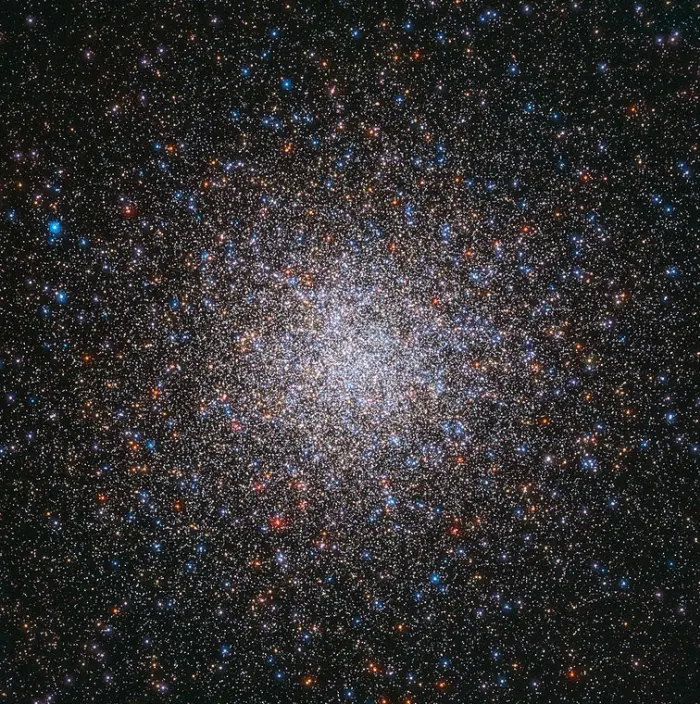
Star clusters are commonly featured in cosmic photoshoots, and are also well-loved by the keen eye of the NASA/ESA Hubble Space Telescope. Messier 2 is located in the constellation of Aquarius (The Water-Bearer), about 55 000 light-years away. It is a globular cluster, a spherical group of stars all tightly bound together by gravity. With a diameter of roughly 175 light-years, a population of 150 000 stars, and an age of 13 billion years, Messier 2 is one of the largest clusters of its kind and one of the oldest associated with the Milky Way. This Hubble image of Messier 2’s core was created using visible and infrared light. Most of the cluster’s mass is concentrated at its centre, with shimmering streams of stars extending outwards into space. It is bright enough that it can even be seen with the unaided eye when observing conditions are exceptionally good. Credit: ESA/Hubble & NASA, G. Piotto et al. (CC BY 4.0)
Messier 72 (M72, NGC 6981)
Messier 72 is a globular cluster located approximately 54,570 light-years away. It lies in the southwestern part of Aquarius, 9 degrees east of Algedi (Alpha Capricorni) and 3 degrees south and 1.5 degrees east of Albali (Epsilon Aquarii). The asterism Messier 73 appears 1.5 degrees east of M72.
With an apparent magnitude of 9.3 and an apparent size of 6.6 arcminutes, Messier 72 can be spotted in 6-inch telescopes, but only appears as a faint nebula. Individual stars can only be resolved in larger instruments. The brightest star in the cluster has an apparent magnitude of 14.2.
Messier 72 has a mass of 168,000 solar masses and a diameter of about 106 light-years. It contains more than 100,000 stars. It is one of the most remote Messier clusters, located well beyond the Galactic centre.
The cluster has an estimated age of 9.5 billion years. It contains several blue giant stars and a significant number of variable stars, mostly of the RR Lyrae type.
Messier 72 was discovered by the French astronomer Pierre Méchain on August 29, 1780. Both Méchain and Charles Messier, who included the cluster in his catalogue, believed the object to be a faint nebula.
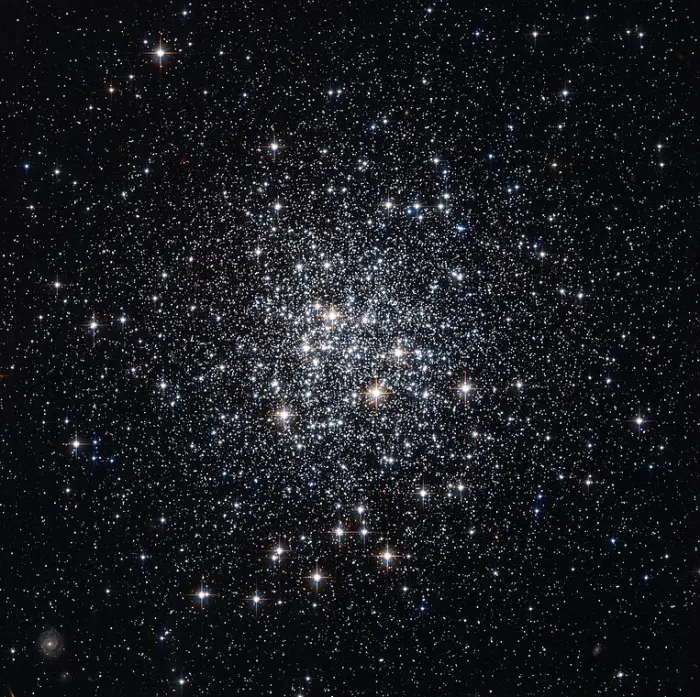
This rich collection of scattered stars, known as Messier 72, looks like a city seen from an airplane window at night, as small glints of light from suburban homes dot the outskirts of the bright city centre. Messier 72 is actually a globular cluster, an ancient spherical collection of old stars packed much closer together at its centre, like buildings in the heart of a city compared to less urban areas. As well as huge numbers of stars in the cluster itself the picture also captures the images of many much more distant galaxies seen between and around the cluster stars. This striking image was taken with the Wide Field Channel of the Advanced Camera for Surveys on the NASA/ESA Hubble Space Telescope. The image was created from pictures taken through yellow and near-infrared filters (F606W and F814W). The exposure times were about ten minutes per filter and the field of view is about 3.4 arcminutes across. Credit: ESA/Hubble and NASA (CC BY 3.0)
Saturn Nebula (NGC 7009, Caldwell 55)
The Saturn Nebula is a planetary nebula located 2,000 – 4,000 light-years away. It is one of the brightest planetary nebulae in the sky, along with its Aquarius neighbour the Helix Nebula (C63), the Dumbbell Nebula (M27) in Vulpecula, and the Ring Nebula (M57) in Lyra. The Saturn Nebula was discovered by Sir William Herschel on September 7, 1782.
The bright planetary nebula has an apparent magnitude of 8.0 and an apparent size of 41 by 35 arcseconds. It has a radius of 0.2 to 0.4 light-years, depending on its exact distance.
The central star shines at magnitude 11.5 and has an effective temperature of 55,000 K. It is around 20 times more luminous than the Sun. The star emits strong ultraviolet radiation, which is responsible for producing the nebula’s fluorescent green tint.
NGC 7009 was named the Saturn Nebula by the English astronomer and telescope maker William Parsons, 3rd Earl of Rosse, in the 19th century. In larger telescopes, its shape appears similar to that of the planet Saturn.
The Saturn Nebula is located in the western portion of Aquarius, a degree west of Nu Aquarii and 2 degrees northeast of Messier 73.
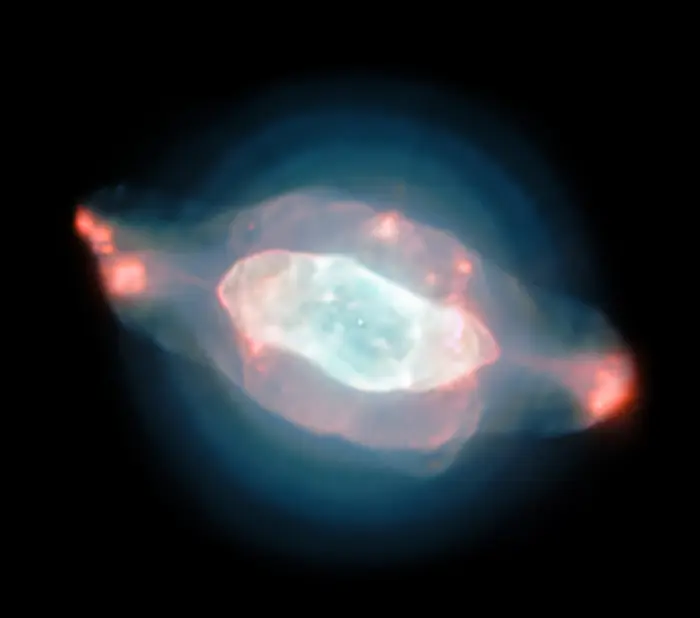
The spectacular planetary nebula NGC 7009, or the Saturn Nebula, emerges from the darkness like a series of oddly-shaped bubbles, lit up in glorious pinks and blues. This colourful image was captured by the powerful MUSE instrument on ESO’s Very Large Telescope (VLT), as part of a study which mapped the dust inside a planetary nebula for the first time. Image credit: ESO/J. Walsh (CC BY 4.0)
Helix Nebula (NGC 7293, Caldwell 63)
The Helix Nebula is a planetary nebula located 650 light-years away. With an apparent magnitude of 7.6 and an apparent size of 25 arcminutes, it can be seen in small telescopes.
The Helix Nebula is one of the closest planetary nebulae to Earth. It was discovered by the German astronomer Karl Ludwig Harding in September 1823. The nebula’s appearance has earned it the nicknames “the Eye of God” and “the Eye of Sauron.” It is not to be mistaken for the other Eye of Sauron Nebula (M1-42) in Sagittarius.
The Helix Nebula appears very similar to the more distant Ring Nebula (Messier 57, NGC 6720) in the constellation Lyra and to the Southern Ring Nebula (Eight-Burst Nebula, NGC 3132) in Vela. All three nebulae look like eyes in space and are often mistaken for one another in images.
The Helix Nebula has a radius of 2.87 light-years. The hot stellar remnant at its centre will eventually become a white dwarf.
The nebula is located about two thirds of the way from Sadalsuud in Aquarius to Fomalhaut in Piscis Austrinus. It appears 1.2 degrees west of Upsilon Aquarii.
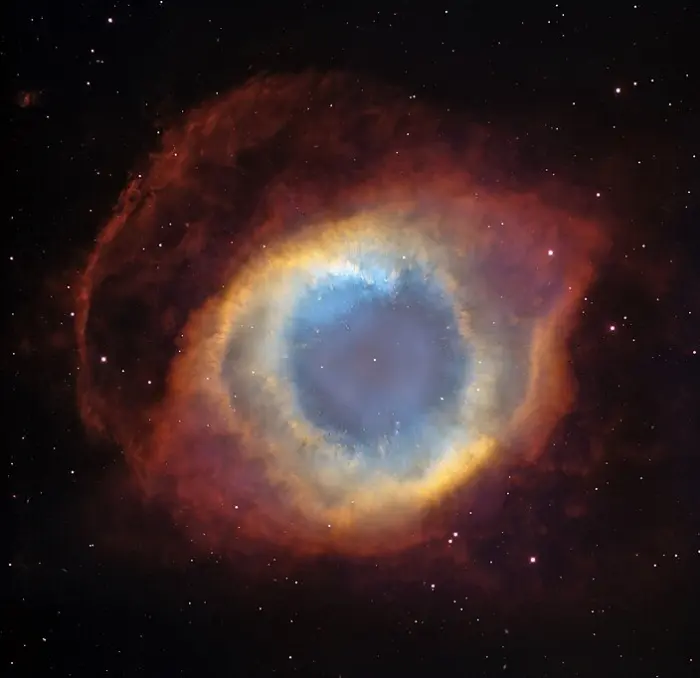
The Helix Nebula captured by the Hubble Space Telescope (HST), image credit: NASA, NOAO, ESA, the Hubble Helix Nebula Team, M. Meixner (STScI), and T.A. Rector (NRAO) (PD)
NGC 7606
NGC 7606 is a spiral galaxy located approximately 98.5 million light-years away. It has an apparent magnitude of 10.8 and an apparent size of 5.4 by 2.2 arcminutes. The galaxy can be observed in 4-inch telescopes, but requires good conditions.
The galaxy is around 165,000 light-years across. It appears only 45 arcminutes northeast of the hot blue star Psi2 Aquarii. It hosts a supermassive black hole with a mass of 15 – 22 million solar masses.
NGC 7606 was discovered by William Herschel on September 28, 1785. The galaxy hosted two supernovae observed in 1965 and 1987. The supernova SN 1965M had an apparent magnitude of 16.0, while SN 1987N shone at magnitude 13.8.
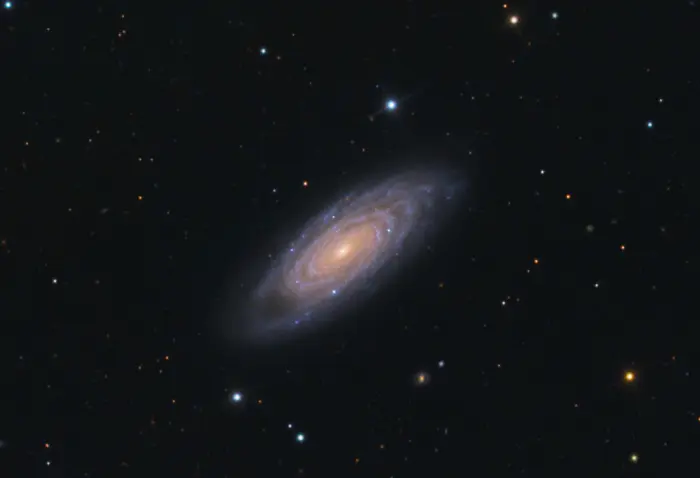
NGC 7606, image: Adam Block/Mount Lemmon SkyCenter/University of Arizona (CC BY-SA 3.0 US)
NGC 7723
NGC 7723 is a barred spiral galaxy located around 91.5 million light-years away. It has a diameter of 95,000 light years and an apparent size of 3.5 by 2.3 arcminutes. With an apparent magnitude of 11.2 it can be seen in 4-inch telescopes in good conditions. The galaxy appears 1.5 degrees north-northwest of the blue-white subgiant star Omega1 Aquarii.
NGC 7723 was discovered by William Herschel on November 27, 1785. It is a member of the NGC 7727 Group of galaxies. It appears about 40 arcminutes southeast of NGC 7727.
A supernova was observed in the galaxy in 1975. Designated SN 1975N, it was classified as a type Ia supernova and it peaked at magnitude 13.8.
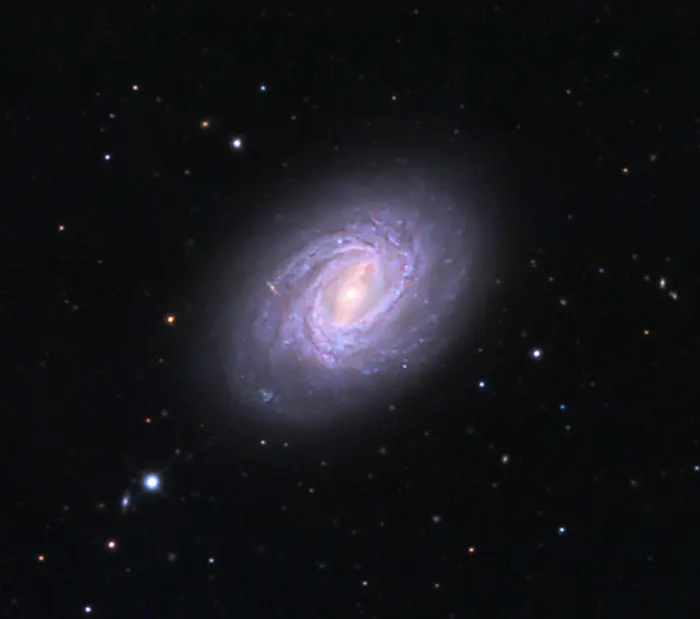
NGC 7723, credit: Adam Block/Mount Lemmon SkyCenter/University of Arizona (CC BY-SA 3.0 US)
NGC 7727
NGC 7727 is a peculiar galaxy located approximately 76 million light-years away. The galaxy contains two galactic nuclei. Each nucleus harbours a supermassive black hole, discovered with the MUSE (multi-unit spectroscopic explorer) instrument on the Very Large Telescope (VLT) in 2021. The nuclei are separated by 1,600 light-years. The black holes have estimated masses of 154 and 6.3 million solar masses.
NGC 7727 is listed as Arp 222 in Halton C. Arp’s Atlas of Peculiar Galaxies, with the description “Galaxy with amorphous spiral arms.” It is similar to the Atoms for Peace Galaxy (NGC 7252), also located in the Aquarius constellation.
The unusual galaxy is likely the product of a merger or two spiral galaxies that occurred about 1 billion years ago. It will probably become an elliptical galaxy in the future.
The galaxy contains several irregular streams and plumes, believed to be what is left of the disks of the two merged galaxies. Astronomers have also detected 23 candidate young globular clusters, which likely formed during the collision.
NGC 7727 has an apparent magnitude of 11.5 and an apparent size of 4.7 by 3.5 arcminutes.
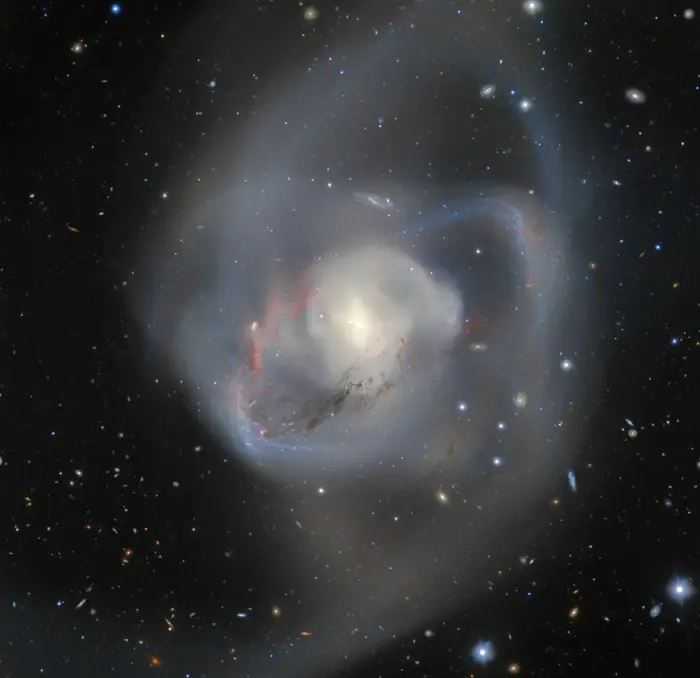
NGC 7727 – Gemini South, one half of the International Gemini Observatory operated by NSF’s NOIRLab, captures the billion-year-old aftermath of a double spiral galaxy collision. At the heart of this chaotic interaction, entwined and caught in the midst of the chaos, is a pair of supermassive black holes — the closest such pair ever recorded from Earth. Image credit: International Gemini Observatory/NOIRLab/NSF/AURA; Image processing: T.A. Rector (University of Alaska Anchorage/NSF’s NOIRLab), J. Miller (International Gemini Observatory/NSF’s NOIRLab), M. Rodriguez (International Gemini Observatory/NSF’s NOIRLab), M. Zamani (NSF’s NOIRLab) (CC BY 4.0)
Atoms for Peace Galaxy (NGC 7252)
The Atoms for Peace Galaxy, catalogued as NGC 7252, is a peculiar galaxy produced in a collision of two smaller galaxies about 2 billion years ago. The galaxy is approximately 220 million light years distant and has an apparent magnitude of 12.7. It is visible in amateur telescopes.
NGC 7252 was nicknamed Atoms for Peace Galaxy because its shape resembles a diagram of an electron orbiting the nucleus of an atom. The name was inspired by Dwight D. Eisenhower’s “Atoms for Peace” speech, delivered in 1953.
The galaxy is catalogued as Arp 226 in Halton Arp’s Atlas of Peculiar Galaxies, published by the California Institute of Technology (Caltech) in 1966.
The galaxy’s central region contains more than 500 ultra-luminous clusters of young, hot, blue stars. These clusters are relatively young, with ages in the range between 50 and 50 million years. They were likely created in the burst of star forming activity caused by the galactic merger.
Deep inside NGC 7252, there is a pinwheel-shaped disk, appearing like a face-on spiral galaxy, but stretching only 10,000 light years across. The disk rotates in the direction opposite to the rest of NGC 7252. It is believed to be a remnant of the merger between the two galaxies.
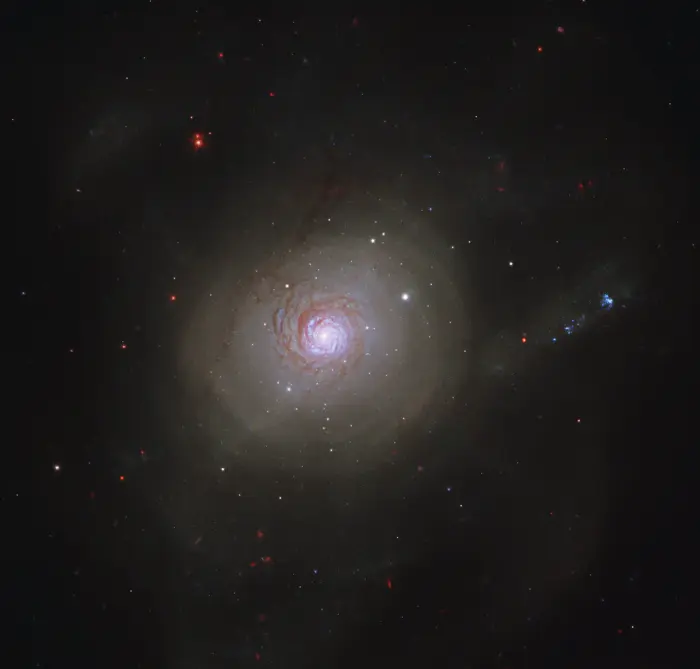
Atoms for Peace Galaxy (NGC 7252), image credit: Judy Schmidt (CC BY 2.0)
Aquarius Dwarf (PGC 65367, DDO 210)
The Aquarius Dwarf (AqrDIG) is a dwarf irregular galaxy located 3.2 million light-years away. It has an apparent visual magnitude of 14.0 and an apparent size of 2.2 by 1.1 arcminutes.
The galaxy displays a blueshift. It is moving toward the Milky Way galaxy at 141 km/s. It is an isolated member of the Local Group and it has not yet made a close approach to the Milky Way.
The Aquarius Dwarf hosts a low level of ongoing star formation and contains a lot of neutral hydrogen. It is one of the least luminous members of the Local Group. The stars in the galaxy have a median age of 6.8 billion years.
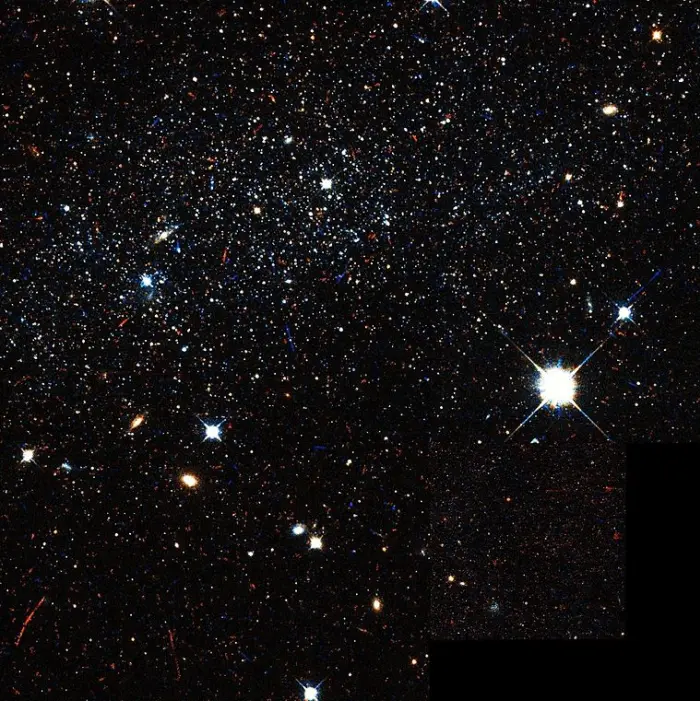
Aquarius Dwarf by the Hubble Space Telescope, image credit: NASA, ESA/Hubble (PD)
NGC 7047
NGC 7047 is an intermediate spiral galaxy classified as a LINER-type galaxy. A LINER (low-ionization nuclear emission-line region) is a galactic nucleus with line emission from neutral or weakly ionized atoms. The galaxy lies approximately 270 million light-years away and has an apparent magnitude of 14.0.
NGC 7047 has an angular size of 1.38 by 0.69 arcminutes, corresponding to a physical diameter of 127,350 light-years.
The galaxy was discovered by the French astronomer Édouard Stephan on August 20, 1873. A type II supernova was detected in the galaxy in January 2009.
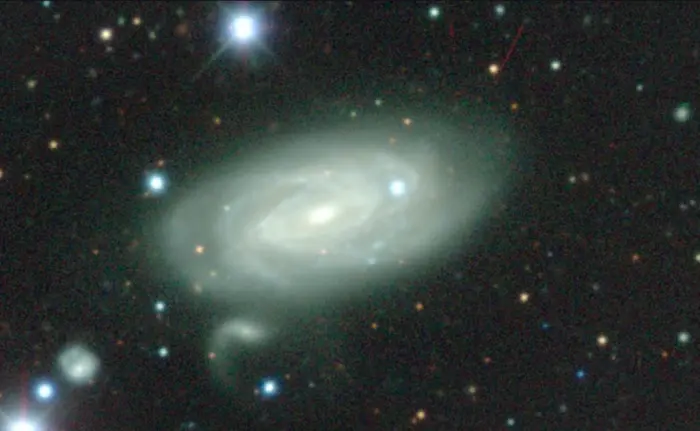
NGC 7047 by Victor M. Blanco (CC0 1.0)
NGC 7069
NGC 7069 is a lenticular galaxy classified as a LINER galaxy. It lies approximately 398 million light years away. It has an apparent magnitude of 14.36 and an apparent size of 1.3 by 0.9 arcminutes.
The galaxy is around 108,600 light-years across. It was discovered by the German astronomer Albert Marth on October 12, 1863.
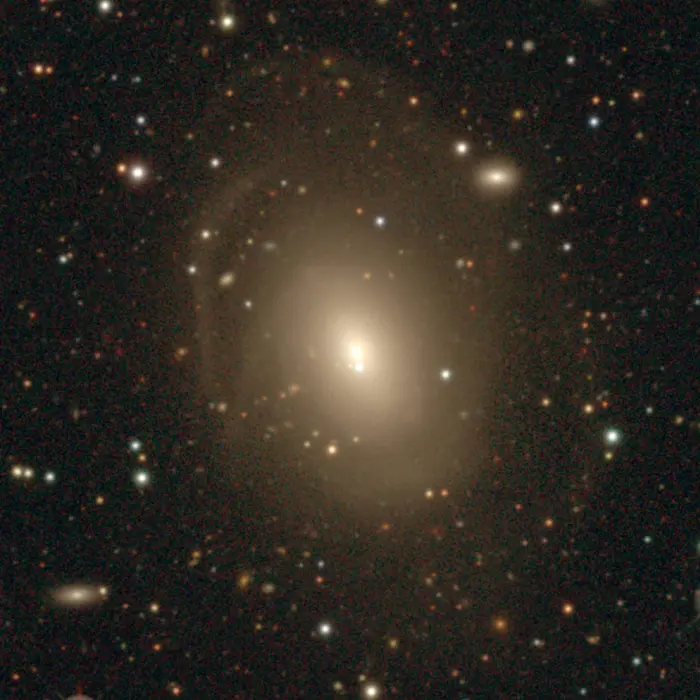
NGC 7069, image: Legacy Surveys / D.Lang (Perimeter Institute) & Meli thev (CC BY 4.0)
NGC 7393
NGC 7393 is a barred spiral galaxy located around 120 million light years away. It has an apparent magnitude of 13.4 and an angular size of 1.9 by 0.9 arcminutes.
The galaxy has a diameter of about 70,000 light-years. It was discovered by William Herschel in October, 1785.
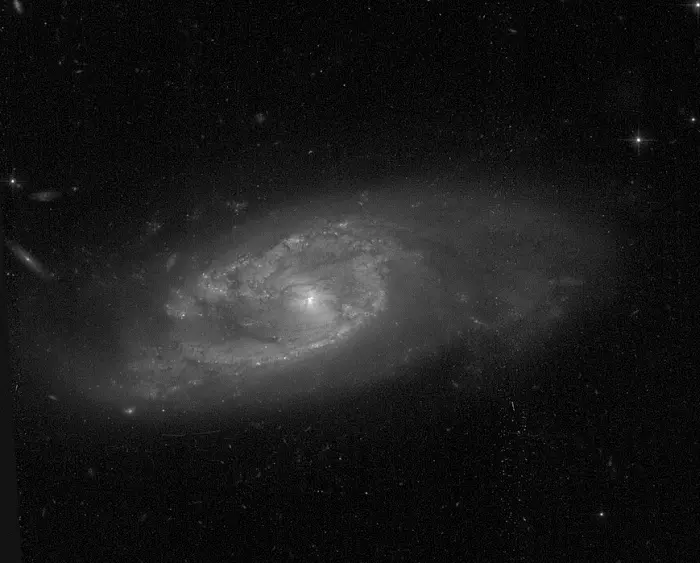
NGC 7393, credit: NASA, ESA/Hubble and Meli thev (CC BY-SA 4.0)
Hickson Compact Group 88
The Hickson Compact Group 88 (HCG 88) is a visual grouping of galaxies located approximately 273 million light-years away in Aquarius. The group is composed of the galaxies NGC 6975 (also catalogued as NGC 6796), NGC 6977, NGC 6978, and MCG-01-53-014.
NGC 6975 is a spiral galaxy with an apparent magnitude of 14.95, discovered by the German astronomer Albert Marth on July 12, 1864. Marth also discovered NGC 6977 and NGC 6978 on July 20, 1863.
NGC 6975 hosted a supernova, SN 2012ga, observed in 2012.
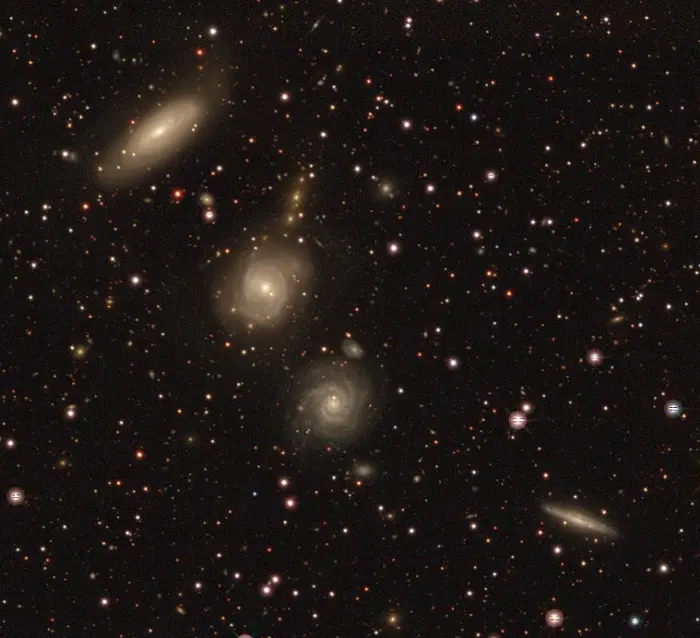
Hickson Compact Group no. 88, containing NGC 6976, NGC 6977 and NGC 6978, image credit: Legacy Surveys / D. Lang (Perimeter Institute), NERSC (CC BY-SA 4.0)
NGC 7492
NGC 7492 is a globular cluster with an apparent magnitude of 11.2, located approximately 80,000 light-years away. It appears 4.2 arcminutes across. The cluster was discovered by William Herschel on September 20, 1786. It is part of the Milky Way’s halo.
NGC 7492 is not a member of the Sagittarius stream, but it is immersed in it. It has a tidal tail stretching for 3.5 degrees. The cluster is interacting with the Milky Way and has a flattened shape. It has an estimated age of 12 billion years.
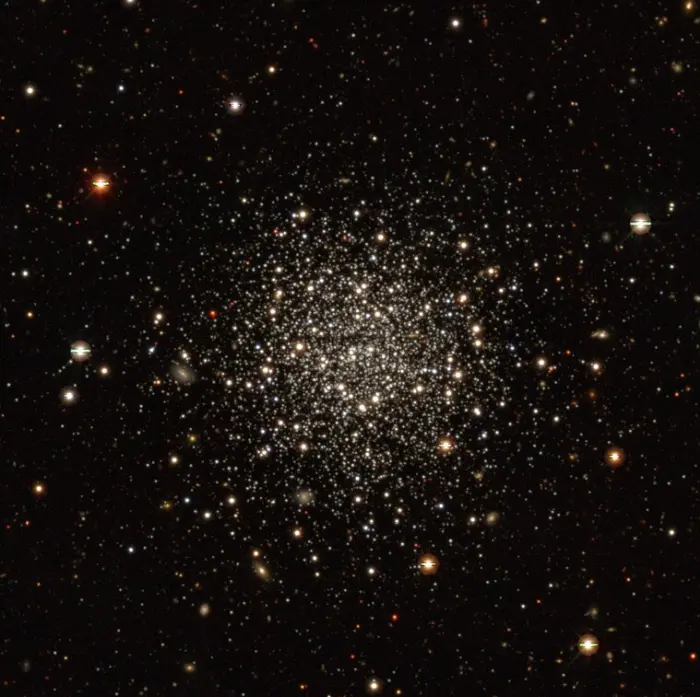
NGC 7492, credit: Legacy Surveys / D. Lang (Perimeter Institute), NERSC (CC BY-SA 4.0)
NGC 7592
NGC 7592 is an interacting pair of galaxies located 306 million light-years away. The pair is classified as a luminous infrared galaxy. It has an infrared luminosity of 1011.33 solar luminosities, and is experiencing a high rate of star formation. The galaxies produce around 26 solar masses per year.
The colliding pair consists of an early type galaxy and a late type spiral galaxy. The two galaxies are separated by 14 arcseconds. Observations have revealed two faint tidal tails, the products of the galactic merger. Astronomers have identified a bright visual source at the end of one of the tails and designated it NGC 7592C.
One of the galaxies is classified as a Seyfert galaxy. It has an active galactic nucleus (AGN) containing a supermassive black hole.
NGC 7592 has an apparent magnitude of 13.5 and an apparent size of 1.2 by 0.9 minutes of arc.
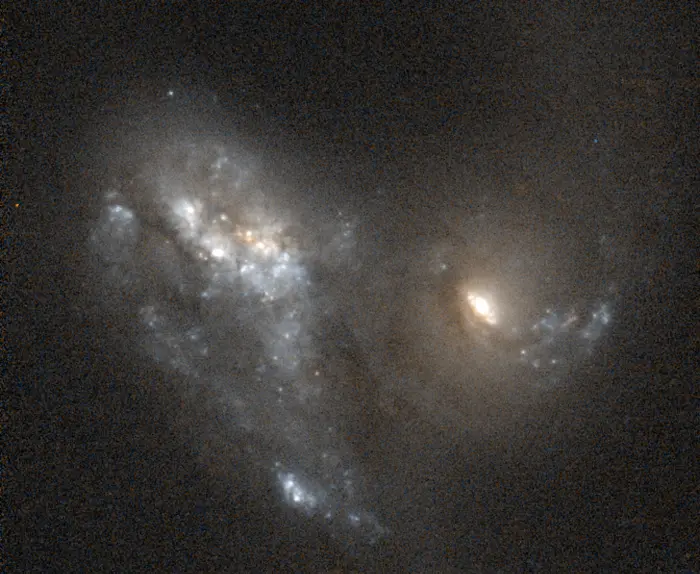
NGC 7592 – Based on observations made with the NASA/ESA Hubble Space Telescope, and obtained from the Hubble Legacy Archive, which is a collaboration between the Space Telescope Science Institute (STScI/NASA), the Space Telescope European Coordinating Facility (ST-ECF/ESA) and the Canadian Astronomy Data Centre (CADC/NRC/CSA) (CC BY-SA 3.0)
NGC 7184
NGC 7184 is a barred spiral galaxy with an apparent magnitude of 11.1 and an apparent size of 6 by 1.5 arcminutes. It is the brightest member of the NGC 7184 Group of galaxies. It lies 99.3 million light years away.
The galaxy was discovered by William Herschel on October 28, 1783. It has a diameter of about 175,000 light years. It hosted a type I supernova, SN 1984N, observed in July 1984.
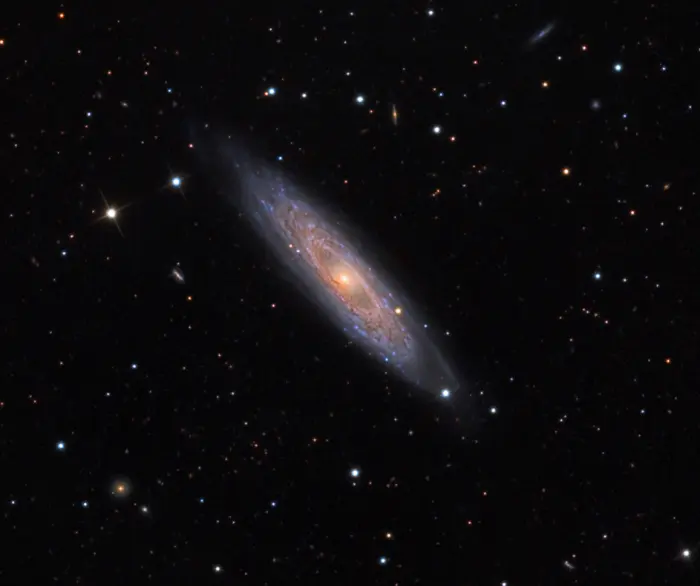
NGC 7184, image credit: Adam Block/Mount Lemmon SkyCenter/University of Arizona (CC BY-SA 3.0 US)
Aquarius Stream
The Aquarius Stream is the closest known stellar stream to the Sun. Stellar streams are associations of stars that orbit a galaxy. These stars once belonged to a globular cluster or a satellite galaxy and were pulled out by tidal forces and stretched along their orbits.
The stars in the Aquarius Stream are believed to have belonged to a dwarf galaxy that was torn apart by the larger Milky Way. The stream formed about 700 million light-years ago.
Discovered in 2010, the Aquarius Stream spans around 30,000 light-years. Its nearest point lies 2,000 light years away and its farthest end is 30,000 light-years away. Most member stars appear in the direction of the Aquarius constellation.
Abell 2597
Abell 2597 is a cluster of galaxies located about 1 billion light-years away. The central member is a giant elliptical galaxy that is surrounded by many other galaxies. The elliptical galaxy contains a supermassive black hole that pulls in vast amounts of cold molecular gas and spreads it back again in a continuous cycle.
Observations with NASA’s Chandra X-ray Observatory in 2015 captured a phenomenon known as cosmic precipitation, a mechanism that makes it possible for hot gas to bring about showers of cool gas clouds that fall into a galaxy. Researchers found that the precipitation loop can slow down the growth of galaxies by preventing these showers from becoming too strong and effectively slowing down star formation.
Observations at the National Radio Astronomy Observatory (NRAO) using the Atacama Large Millimeter/submillimeter Array (ALMA) in 2018 captured one such event, a cluster of large gas clouds showering on the galaxy’s central black hole.
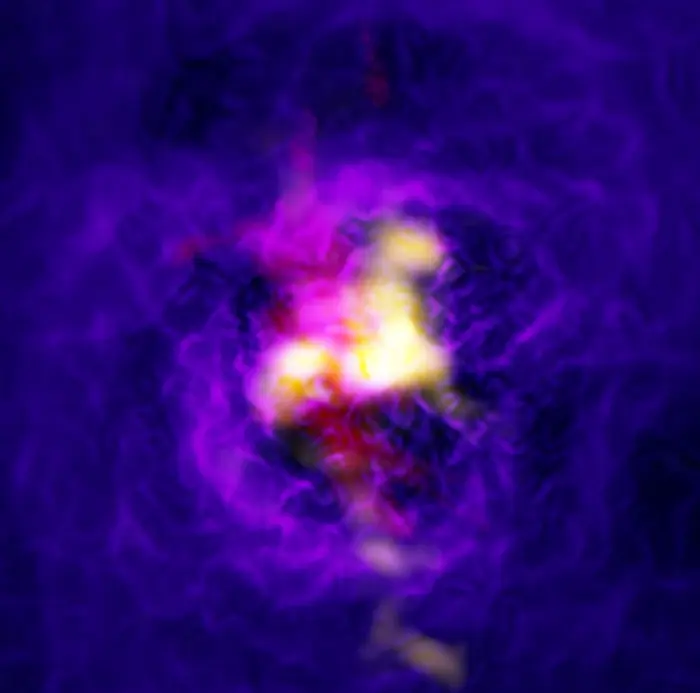
Composite image of the Abell 2597 galaxy cluster showing the fountain-like flow of gas powered by the supermassive black hole in the central galaxy. The yellow is ALMA data showing cold gas. The red is data from the MUSE instrument on ESO’s Very Large Telescope showing the hot hydrogen gas in the same region. The blue-purple is the extended hot, ionized gas as imaged by the Chandra X-ray Observatory. The yellow ALMA data shows infalling material and the red MUSE data shows material launched in a vast spout by the black hole. Credit: ALMA (ESO/NAOJ/NRAO), Tremblay et al.; NRAO/AUI/NSF, B. Saxton; NASA/Chandra; ESO/VLT (CC BY 4.0)
PGC 1228197
PGC 1228197 (also catalogued as WINGS J211347.41+022834.9 and JO206) is a spiral galaxy located approximately 700 light-years away. The galaxy is 160,000 light-years across. It is a member of the galaxy cluster II ZW 108 and classified as a jellyfish galaxy.
Jellyfish galaxies are typically found in galaxy clusters, where they are affected by ram pressure stripping. As a result, they exhibit high rates of star formation in extended tails of stars and gas.
PGC 1228197 has a tail over 293,000 light-years wide, composed of ionized gas that has been stripped from the galaxy as a result of interaction with other galaxies in the cluster.
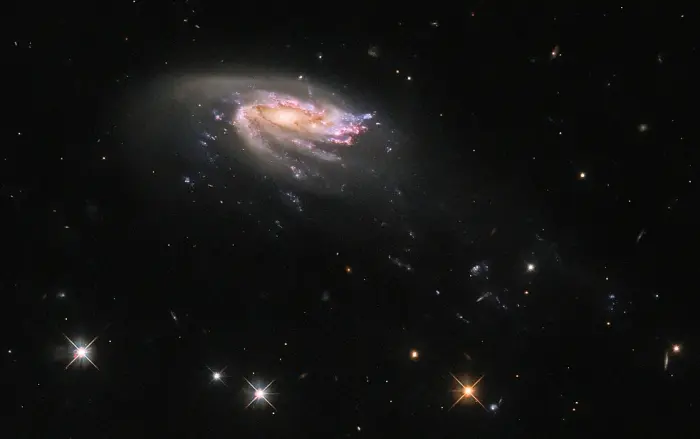
The jellyfish galaxy JO206 trails across this image from the NASA/ESA Hubble Space Telescope, showcasing a colourful star-forming disc surrounded by a pale, luminous cloud of dust. A handful of bright stars with criss-cross diffraction spikes stand out against an inky black backdrop at the bottom of the image. In this image, the disc of JO206 is trailed by long tendrils of bright star formation that stretch towards the bottom right of this image, just as jellyfish trail tentacles behind them. The tendrils of jellyfish galaxies are formed by the interaction between galaxies and the intra-cluster medium, a tenuous superheated plasma that pervades galaxy clusters. As galaxies move through galaxy clusters they ram into the intracluster medium, which strips gas from the galaxies and draws it into the long tendrils of star formation. Image: ESA/Hubble & NASA, M. Gullieuszik and the GASP team (CC BY-SA 4.0)
RX J2129.7+0005 BCG
RX J2129.7+0005 BCG (PGC 1156801) is a massive elliptical galaxy located 3.119 billion light-years away. It is the brightest member of the cluster RX J2129.7+0005. (BCG stands for Brightest Cluster Galaxy.)
With a diameter of 515,000 light-years, RX J2129.7+0005 BCG is one of the largest galaxies discovered to date. It likely formed in a merger of smaller spiral or elliptical galaxies. It is classified as an active galaxy and a radio galaxy.
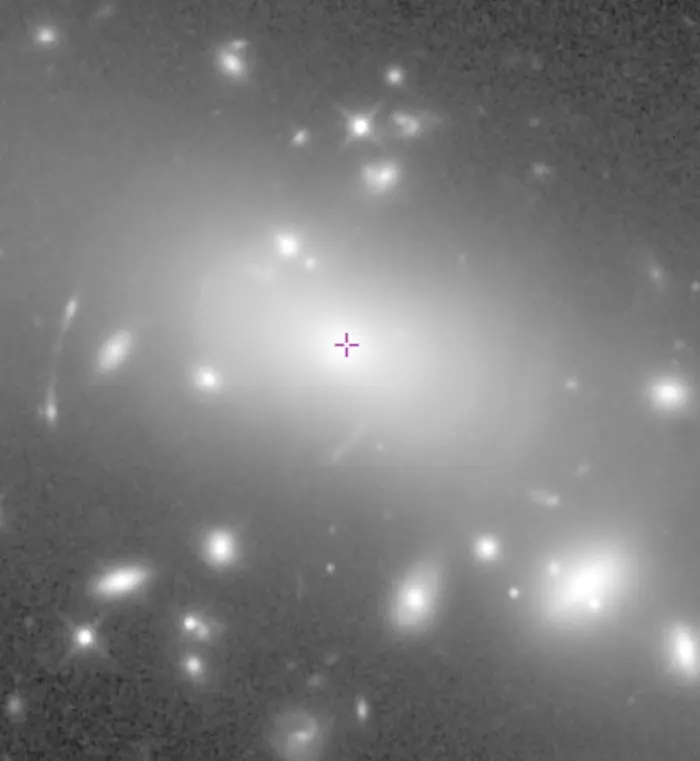
RX J2129.7+0005 BCG, image credit: CDS Portal (CC0 1.0)
Lyman-alpha blob 1
Lyman-alpha blob 1 (LAB-1) was the first object of its kind to be discovered and serves as the prototype of Lyman-alpha blobs. It is a vast cosmic gas cloud that emits the Lyman-alpha emission line (a spectral line of hydrogen). It lies 11.5 billion light-years away.
LAB-1 was discovered by a team led by American astronomer Charles Steidel in 2000. The astronomers found the object while looking for high-redshift galaxies in the young universe with the 200-inch Hale Telescope at the Palomar Observatory in California.
LAB-1 is one of the largest Lyman-alpha blobs discovered to date. It is about 300,000 light-years across, or three times the size of the Milky Way. It contains several primordial galaxies, one of which is an active galaxy.
The origin of the Lyman-alpha emission and the source of exceptionally high luminosity of these objects is still uncertain. Astronomers believe that the blobs are powered by the embedded galaxies. Lyman-alpha blobs are typically found at great distances and we see them as they were when the universe was still very young.
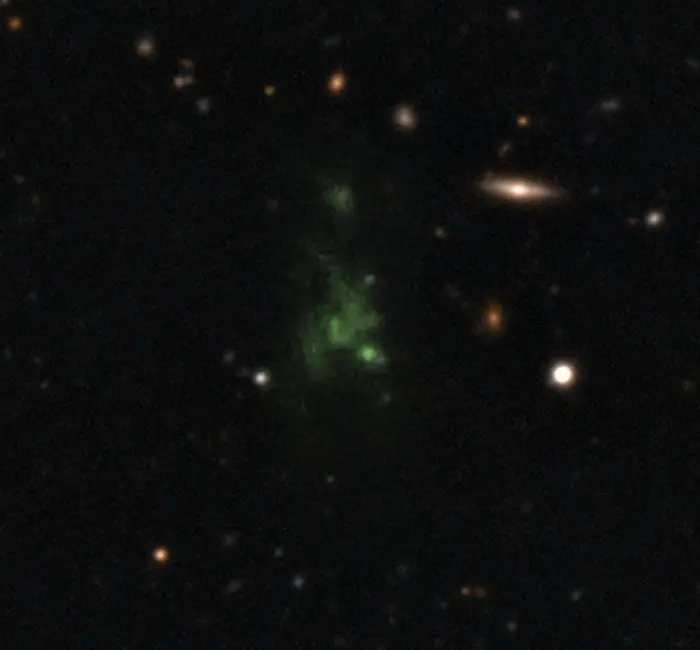
This image shows one of the largest known single objects in the Universe, the Lyman-alpha blob LAB-1. This picture is a composite of two different images taken with the FORS instrument on the Very Large Telescope (VLT) — a wider image showing the surrounding galaxies and a much deeper observation of the blob itself at the centre made to detect its polarisation. The intense Lyman-alpha ultraviolet radiation from the blob appears green after it has been stretched by the expansion of the Universe during its long journey to Earth. These new observations show for the first time that the light from this object is polarised. This means that the giant “blob” must be powered by galaxies embedded within the cloud. Image credit: ESO/M. Hayes (CC BY 4.0)
NGC 7257
NGC 7257 is an intermediate spiral galaxy with an apparent magnitude of 13.7 and an apparent size of 1.9 by 1.4 arcminutes. It is also catalogued as NGC 7260 in the New General Catalogue. The galaxy was discovered by Albert Marth on October 1, 1864. It lies 210 – 215 million light-years away and has a physical diameter of around 130,000 light-years.
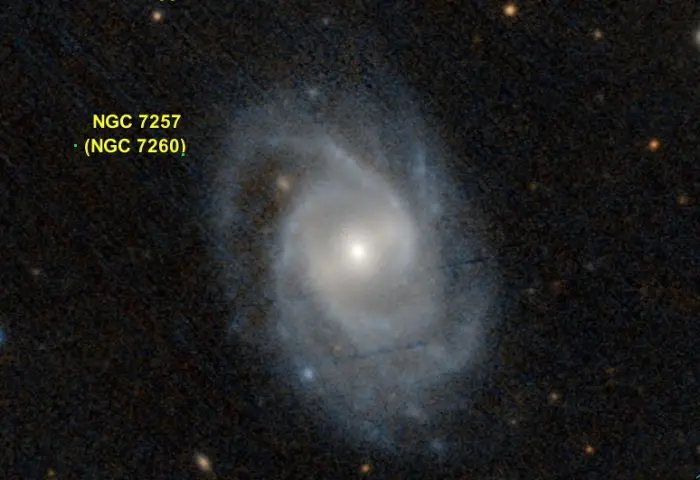
NGC 7257 (PanSTARRS survey), image credit: Donald Pelletier (CC0 1.0)
NGC 7759
NGC 7759 is a lenticular galaxy located approximately 336.3 light-years away. It has an apparent magnitude of 13.95. The galaxy was discovered by the American astronomer Francis Preserved Leavenworth on November 28, 1885. American astronomer Lewis Swift discovered it independently in 1886.
NGC 7600
NGC 7600 is a lenticular galaxy located 160 million light years from Earth. It has an apparent visual magnitude of 12.95 and an apparent size of 2.5 by 1.1 arcminutes. The galaxy was discovered by William Herschel on September 10, 1785. It stretches about 160,000 light-years across and has an extended halo.
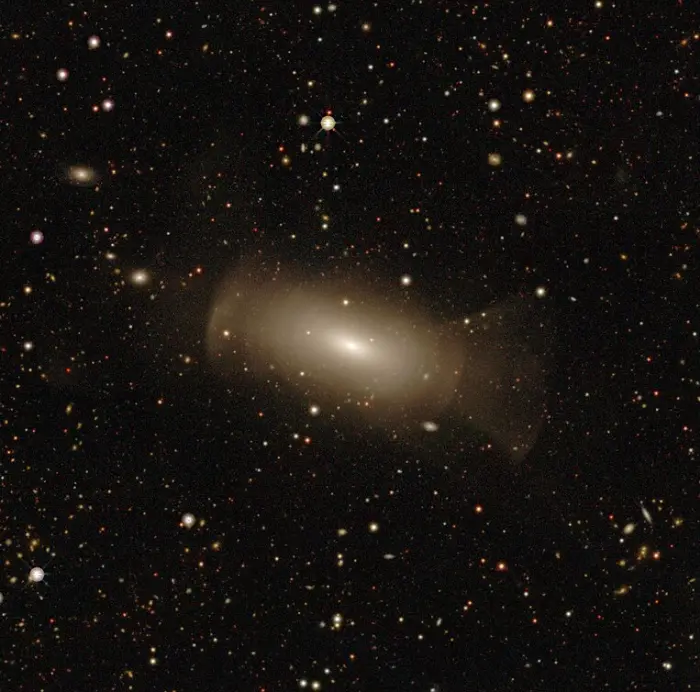
NGC 7600, image: Legacy Surveys / D. Lang (Perimeter Institute), NERSC (CC BY 4.0)